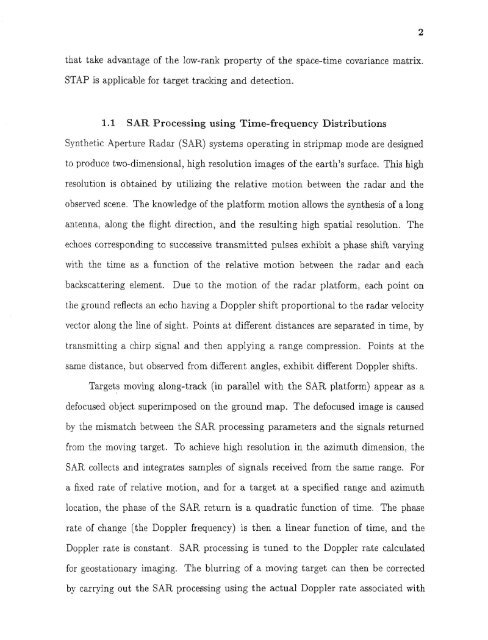Space/time/frequency methods in adaptive radar - New Jersey ...
Space/time/frequency methods in adaptive radar - New Jersey ...
Space/time/frequency methods in adaptive radar - New Jersey ...
Create successful ePaper yourself
Turn your PDF publications into a flip-book with our unique Google optimized e-Paper software.
2that take advantage of the low-rank property of the space-<strong>time</strong> covariance matrix.STAP is applicable for target track<strong>in</strong>g and detection.1.1 SAR Process<strong>in</strong>g us<strong>in</strong>g Time-<strong>frequency</strong> DistributionsSynthetic Aperture Radar (SAR) systems operat<strong>in</strong>g <strong>in</strong> stripmap mode are designedto produce two-dimensional, high resolution images of the earth's surface. This highresolution is obta<strong>in</strong>ed by utiliz<strong>in</strong>g the relative motion between the <strong>radar</strong> and theobserved scene. The knowledge of the platform motion allows the synthesis of a longantenna, along the flight direction, and the result<strong>in</strong>g high spatial resolution. Theechoes correspond<strong>in</strong>g to successive transmitted pulses exhibit a phase shift vary<strong>in</strong>gwith the <strong>time</strong> as a function of the relative motion between the <strong>radar</strong> and eachbackscatter<strong>in</strong>g element. Due to the motion of the <strong>radar</strong> platform, each po<strong>in</strong>t onthe ground reflects an echo hav<strong>in</strong>g a Doppler shift proportional to the <strong>radar</strong> velocityvector along the l<strong>in</strong>e of sight. Po<strong>in</strong>ts at different distances are separated <strong>in</strong> <strong>time</strong>, bytransmitt<strong>in</strong>g a chirp signal and then apply<strong>in</strong>g a range compression. Po<strong>in</strong>ts at thesame distance, but observed from different angles, exhibit different Doppler shifts.Targets mov<strong>in</strong>g along-track (<strong>in</strong> parallel with the SAR platform) appear as adefocused object superimposed on the ground map. The defocused image is causedby the mismatch between the SAR process<strong>in</strong>g parameters and the signals returnedfrom the mov<strong>in</strong>g target. To achieve high resolution <strong>in</strong> the azimuth dimension, theSAR collects and <strong>in</strong>tegrates samples of signals received from the same range. Fora fixed rate of relative motion, and for a target at a specified range and azimuthlocation, the phase of the SAR return is a quadratic function of <strong>time</strong>. The phaserate of change (the Doppler <strong>frequency</strong>) is then a l<strong>in</strong>ear function of <strong>time</strong>, and theDoppler rate is constant. SAR process<strong>in</strong>g is tuned to the Doppler rate calculatedfor geostationary imag<strong>in</strong>g. The blurr<strong>in</strong>g of a mov<strong>in</strong>g target can then be correctedby carry<strong>in</strong>g out the SAR process<strong>in</strong>g us<strong>in</strong>g the actual Doppler rate associated with
















